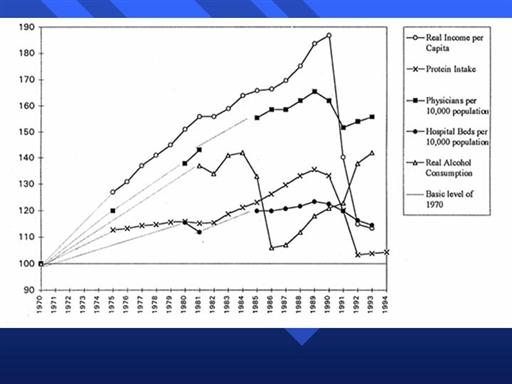| front |1 |2 |3 |4 |5 |6 |7 |8 |9 |10 |11 |12 |13 |14 |15 |16 |17 |18 |19 |20 |21 |22 |23 |24 |25 |26 |27 |28 |29 |30 |31 |32 |33 |34 |review |
 |
SOURCES: Real Per Capita Income and Daily Protein Intake
provided by the Laboratory for Prognosis of Population Wages
and
Consumption, Institute for Economic Forecasting, Moscow; Physicians and
Hospital Beds Per 10,000 Population from "Sources of Statistical Data,"
given in this paper; Real Alchohol Consumption, by Shkolnikov, Nemtsov,
1995, and evaluated by A. Nemtsov.
Figure 4.14--Real Per Capita Income, Daily Protein Intake,
Number of Physicians and Hospital Beds per 10,000, and
Real Alcohol Consumption, Each Compared to the Basic Level of 1970:
Russia, 1970-1994
As such, a large part of the striking rise in mortality in the
1990s can be ascribed to the effects of a number of serious shifts in
Russian society. All of them are closely interrelated. It is possible,
however, to extract the two principal factors among them. These are: 1)
lower living standards; and 2) social disorganization. We cannot discuss
the links between these two here. However, we can say that the negative
changes in living conditions themselves are not as bad as to lead to the
massive deterioration in public health evident in the shifts in
mortality by age and cause of death in 1992-93. In many countries, where
living standards are much worse than in Russia--even in some developing
countries--male life expectancy is significantly higher. We can suppose
that some kind of complex interaction effect, coming from both principal
factors, is responsible for the deteriorating health situation. In that
case, the negative influence of the first component (real living
conditions) is reinforced by the second group of factors
(socio-psychological conditions) and vice versa.
|